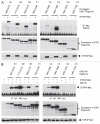Role of STRAP in regulating GSK3β function and Notch3 stabilization
- PMID: 21502811
- PMCID: PMC3127163
- DOI: 10.4161/cc.10.10.15630
Role of STRAP in regulating GSK3β function and Notch3 stabilization
Abstract
Glycogen synthase kinase 3β (GSK3β) can regulate a broad range of cellular processes in a variety of cell types and tissues through its ability to phosphorylate its substrates in a cell- and time-specific manner. Although it is known that Axin and presenilin help to recruit β-catenin/Smad3 and tau protein to GSK3β, respectively, it is not clear how many of the other GSK3β substrates are recruited to it. Here, we have established the binding of GSK3β with a novel scaffold protein, STRAP, through its WD40 domains. In a new finding, we have observed that STRAP, GSK3β and Axin form a ternary complex together. We show for the first time that intracellular fragment of Notch3 (ICN3) binds with GSK3β through the ankyrin repeat domain. This binding between STRAP and GSK3β is reduced by small-molecule inhibitors of GSK3β. Further studies revealed that STRAP also binds ICN3 through the ankyrin repeat region, and this binding is enhanced in a proteasomal inhibition-dependent manner. In vivo ubiquitination studies indicate that STRAP reduces ubiquitination of ICN3, suggesting a role of STRAP in stabilizing ICN3. This is supported by the fact that STRAP and Notch3 are co-upregulated and co-localized in 59% of non-small cell lung cancers, as observed in an immunohistochemical staining of tissue microarrays. These results provide a potential mechanism by which STRAP regulates GSK3β function and Notch3 stabilization and further support the oncogenic functions of STRAP.
Figures








Comment in
-
GM130: new insights into oocyte asymmetric division.Cell Cycle. 2011 Aug 1;10(15):2419. doi: 10.4161/cc.10.15.15932. Epub 2011 Aug 1. Cell Cycle. 2011. PMID: 21734461 No abstract available.
Similar articles
-
Axin negatively affects tau phosphorylation by glycogen synthase kinase 3beta.J Neurochem. 2002 Nov;83(4):904-13. doi: 10.1046/j.1471-4159.2002.01197.x. J Neurochem. 2002. PMID: 12421363
-
GSKIP is homologous to the Axin GSK3beta interaction domain and functions as a negative regulator of GSK3beta.Biochemistry. 2006 Sep 26;45(38):11379-89. doi: 10.1021/bi061147r. Biochemistry. 2006. PMID: 16981698
-
Structural basis for recruitment of glycogen synthase kinase 3beta to the axin-APC scaffold complex.EMBO J. 2003 Feb 3;22(3):494-501. doi: 10.1093/emboj/cdg068. EMBO J. 2003. PMID: 12554650 Free PMC article.
-
S100A4 negatively regulates β-catenin by inducing the Egr-1-PTEN-Akt-GSK3β degradation pathway.Cell Signal. 2014 Oct;26(10):2096-106. doi: 10.1016/j.cellsig.2014.06.007. Epub 2014 Jun 26. Cell Signal. 2014. PMID: 24975844
-
Glycogen synthase kinase 3β (GSK3β) and presenilin (PS) are key regulators of kinesin-1-mediated cargo motility within axons.Front Cell Dev Biol. 2023 Jun 9;11:1202307. doi: 10.3389/fcell.2023.1202307. eCollection 2023. Front Cell Dev Biol. 2023. PMID: 37363727 Free PMC article. Review.
Cited by
-
Overexpression of a novel regulator of p120 catenin, NLBP, promotes lung adenocarcinoma proliferation.Cell Cycle. 2013 Aug 1;12(15):2443-53. doi: 10.4161/cc.25451. Epub 2013 Jun 28. Cell Cycle. 2013. PMID: 23839039 Free PMC article.
-
Serine-Threonine Kinase Receptor Associate Protein (STRAP) confers an aggressive phenotype in neuroblastoma via regulation of Focal Adhesion Kinase (FAK).J Pediatr Surg. 2022 Jun;57(6):1026-1032. doi: 10.1016/j.jpedsurg.2022.01.064. Epub 2022 Feb 14. J Pediatr Surg. 2022. PMID: 35272839 Free PMC article.
-
Cancer-wide in silico analyses using differentially expressed genes demonstrate the functions and clinical relevance of JAG, DLL, and NOTCH.PLoS One. 2024 Jul 29;19(7):e0307943. doi: 10.1371/journal.pone.0307943. eCollection 2024. PLoS One. 2024. PMID: 39074091 Free PMC article.
-
Tandem Mass Tag-Based Quantitative Proteomic Analysis of ISG15 Knockout PK15 Cells in Pseudorabies Virus Infection.Genes (Basel). 2021 Sep 30;12(10):1557. doi: 10.3390/genes12101557. Genes (Basel). 2021. PMID: 34680952 Free PMC article.
-
Novel role of STRAP in progression and metastasis of colorectal cancer through Wnt/β-catenin signaling.Oncotarget. 2016 Mar 29;7(13):16023-37. doi: 10.18632/oncotarget.7532. Oncotarget. 2016. PMID: 26910283 Free PMC article.
References
-
- Cross DA, Alessi DR, Cohen P, Andjelkovich M, Hemmings BA. Inhibition of glycogen synthase kinase-3 by insulin mediated by protein kinase B. Nature. 1995;378:785–789. - PubMed
-
- Lai EC. Notch signaling: control of cell communication and cell fate. Development. 2004;131:965–973. - PubMed
-
- Lewis J. Notch signalling and the control of cell fate choices in vertebrates. Semin Cell Dev Biol. 1998;9:583–589. - PubMed
Publication types
MeSH terms
Substances
Grants and funding
LinkOut - more resources
Full Text Sources
Miscellaneous
